When individual PC components no longer meet modern system requirements they are usually changed. However, some users approach this issue more flexibly. Instead of purchasing, for example, an expensive processor, they prefer to use overclocking utilities. Competent actions help to achieve excellent results and postpone the purchase for some time in advance.
There can be two ways to overclock the processor - changing the parameters in the BIOS and using special software. Today we want to talk about universal programs for overclocking processors by increasing the frequency system bus(FSB).

This program is great for users with modern but not enough powerful computer. Along with this, this great program for overclocking intel core i5 and others good processors, whose default power is not 100% realized. SetFSB supports many motherboards, and it is its support that you need to rely on when choosing a program for overclocking. Full list can be found on the official website.
An added benefit to choosing this program is that it can determine its own PLL information. Knowing its ID is simply necessary, because without this overclocking will not take place. Otherwise, in order to identify the PLL, it is necessary to disassemble the PC and look for the corresponding inscription on the chip. If computer owners can do this, then laptop users are in a difficult situation. With SetFSB, you can find out the necessary information programmatically, and then start overclocking.
All parameters obtained by overclocking are reset after reset. Windows boot. Therefore, if something went wrong, the chance to do something irreversible is reduced. If you think that this is a minus of the program, then we immediately hasten to say that all other overclocking utilities work on the same principle. After the found overclocking threshold has been found, you can put the program into autoload and enjoy the resulting performance boost.
The minus of the program is the special "love" of the developers for Russia. We will have to pay $6 to purchase the program.
CPUFSB
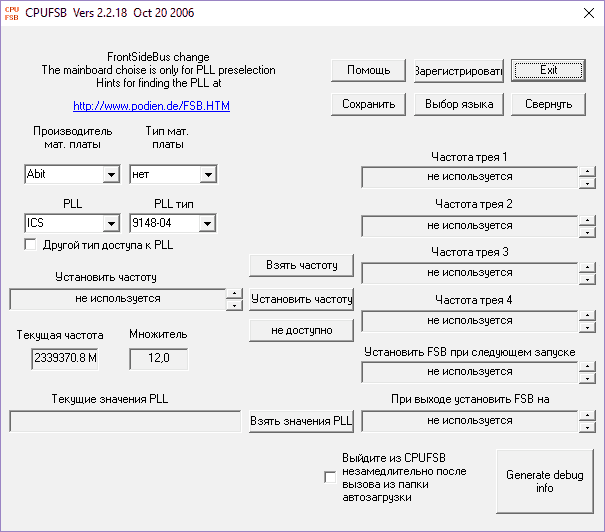
The program is similar to the previous one. Its advantages are the presence of a Russian translation, work with new parameters until reboot, as well as the ability to switch between the selected frequencies. That is, where maximum performance is needed, we switch to the most high frequency. And where you need to slow down - we reduce the frequency in one click.
Of course, one cannot fail to mention the main advantage of the program - support for a huge number of motherboards. Their number is even greater than that of SetFSB. This means that owners of even the most obscure components get a chance to overclock.
Well, from the minuses - you have to learn the PLL yourself. Alternatively, use SetFSB for this purpose, and overclock CPUFSB.
SoftFSB
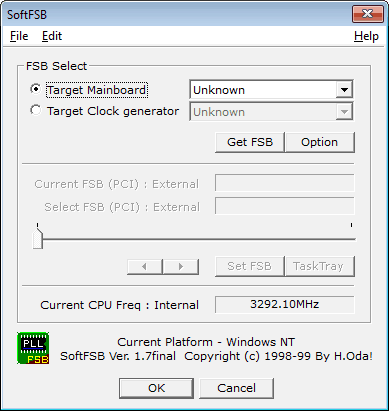
Owners of old and very old computers especially want to overclock their PC, and there are programs for them too. The same old ones, but working. SoftFSB is just such a program that allows you to get the most valuable% in performance. And even if you have a motherboard whose name you see for the first time in your life, there is a good chance that SoftFSB supports it.
The advantages of this program include the absence of the need to know your PLL. However, this may be necessary if motherboard will not be on the list. The software works in the same way, from under Windows, autorun can be configured in the program itself.
Minus SoftFSB - the program is a real antique among overclockers. It is no longer supported by the developer, and it will not be able to overclock your modern PC.
We told you about three great programs that allow you to unlock the full potential of processors and get a performance boost. In conclusion, I would like to say that it is important not only to choose a program for overclocking, but also to know all the subtleties of overclocking as an operation. We recommend that you familiarize yourself with all the rules and possible consequences, and only then download the program for overclocking your PC.
In this article, you will learn how to properly overclock the processor on a computer or laptop.
Navigation
Overclocking is the process of increasing the clock speed of your CPU, that is, the processor. The performance is already there, but by default the manufacturer (Intel and AMD) limits the performance of the processor. This is done to ensure that the processor lasts as long as possible. But what if you need to increase the processor clock speed? More on this later!
What processors can be overclocked?
Today we will not focus on a specific chipset, but rather look at easy ways to overclock the CPU. If you want to fine-tune and get maximum performance from your CPU, you will need to fully understand the overclocking process and also sacrifice a few weeks for overclocking as it is a lengthy trial and error process.
Achieving the best overclocking is not an easy task and often requires good "silicone lottery". The lottery comes from different processors having different voltage requirements to reach a certain clock speed. For example, looking at the same model Intel processor Core i7 3770K, the CPU will need 1.35 volts to overclock 4.5 GHz, while the other will require 1.15 volts at the same clock speed.
Attention! If you want to overclock a laptop, you must be extremely careful, given that they have a limit.
Warnings, risks and understanding the art of overclocking
Before jumping into the overclocking process, you need to know that there are some risks to consider.
First, overclocking your processor will void your computer's warranty. Therefore, if any problems arise after overclocking, you will not be able to return the PC to the store, or get a free repair for it. Overclocking can damage your CPU or other components.
If you are going to overclock your CPU, you should be aware that you can damage your components by increasing your BCLK beyond the optimum. Not too technical overclocking BCLK improves the performance of the entire motherboard, which means that everything that is directly connected to your motherboard, will be overclocked. Yes, this also includes your wireless card!
Overclocking BCLK is therefore a bit dangerous, but if done right, you can achieve fantastic results. We only offer BCLK overclocking if you know all the ins and outs of your motherboard chipset and processor.
The overclocking multiplier can also be dangerous. To achieve a higher processor speed, you need to increase the same multiplier. In order for your processor to handle higher speeds, you need to increase the amount of power (volts) going into it - this is called increasing the Vcore.
As you increase Vcore, your CPU temperatures will also increase as your CPU will have more volts, at an incredibly fast rate.
Think of it as a motor, the faster the motor spins, the hotter it gets. More VCore means more cycles in your CPU and therefore more heat.
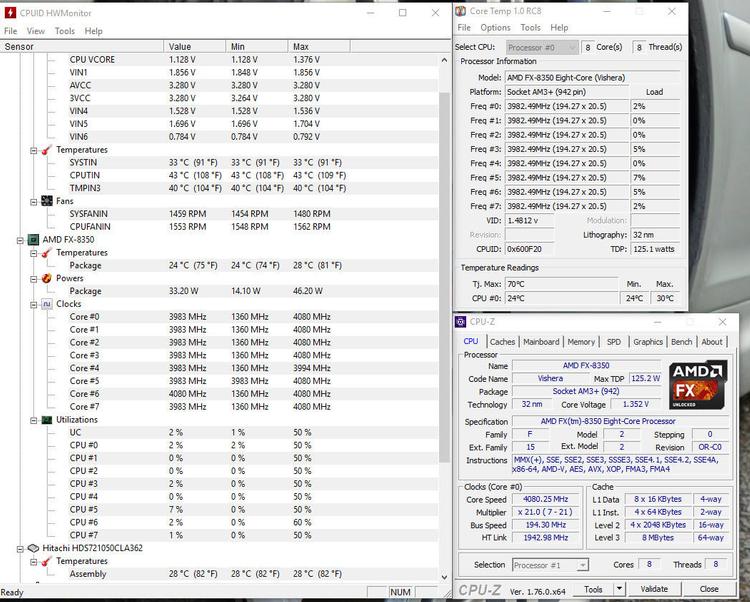
Since overclocking involves pushing your processor beyond its factory settings, you should keep an eye on it.
The maximum temperature of the processor, also known as TJ Max, is perhaps the most important number to track when overclocking, since each processor has a thermal threshold.
If you exceed this temperature, your computer will experience a Blue Screen of Death (BSOD). If this happens regularly, you may experience data loss and, more importantly, hardware damage due to the constantly high temperature of your CPU, that is, the processor.
If you are going to overclock your processor as much as possible, then you need to buy a powerful cooler for intensive cooling.
In order for the whole process to go smoothly and without incidents, you need to download three programs: Core Temp, Real Temp or HW Monitor. The programs will tell you about your CPU's core temperatures and will also tell you the maximum temperature your CPU can handle before it shuts down.
To test overclocking, many users trust the results Prime95, Aida64 And Cinebench, these programs load the processor to the maximum load.
Worth noticing, the above programs should be used if you are planning non-standard overclocking.
In this article, we will only look at overclocks that should be completely stable and that are done with the push of a few buttons.
We also recommend downloading CPU Z, because it will display real-time measurements of the internal frequency of each processor core, the frequency of your memory, and even the details of your motherboard.
What processors can be overclocked?

Usually, modern processors amenable to overclocking and increasing the clock frequency by at least 1.5 GHz. But with older generations of processors, problems can arise.
If you are unsure about your processor, then Intel has detailed specifications, or you can try overclocking, if it fails, then your processor cannot be overclocked. A number of AMD FX processors are unlocked, usually the most recent AMD chips can be overclocked.
Using overclocking software
Intel processor overclocking
In the event that you have an Intel processor, then use the utility Extreme Tuning Utility. This program allow you to get into the settings that you will need to change in order to overclock parameters such as power, voltage, core and memory.
Remember! You should constantly monitor your CPU temperature and possibly run a stress test with Prime95 utility for several hours to ensure your PC is stable.

AMD Processor Overclocking
On AMD you will need to download over drive, which is effectively the same as the Intel XTU. It includes automatic configuration if you're not sure what you're doing.
This program is also easy to use, and it is with the help of it that overclocking is carried out very quickly and does not require multiple reboots, since changes are made in real time.
Again, just like on Intel, you need to make sure you have the necessary monitoring tools in place to keep the CPU from overheating.
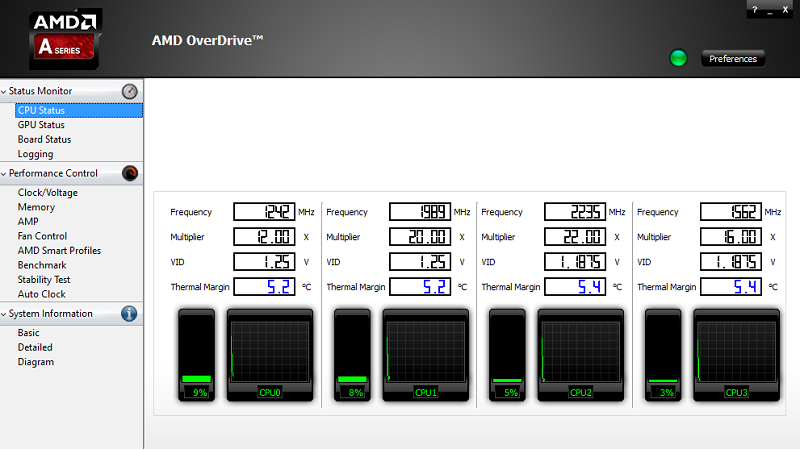
Using the BIOS for Intel and AMD
Most overclockers, especially experienced ones, will tell you about BIOS overclocking. This is often recommended as you won't have conflicts with software and, even more so, will have complete control over all the parameters that your motherboard and processor has to offer.
In order to enter BIOS settings, you need to use the F8 or Del key. If you don't know how to access BIOS, don't forget to check.
Depending on your motherboard, there should be an option to overheat "one click". For example, on Asus mid-range and high-end motherboards, you should be able to enable Ai Overclock Tuner, which will automatically give you moderate overclocking.
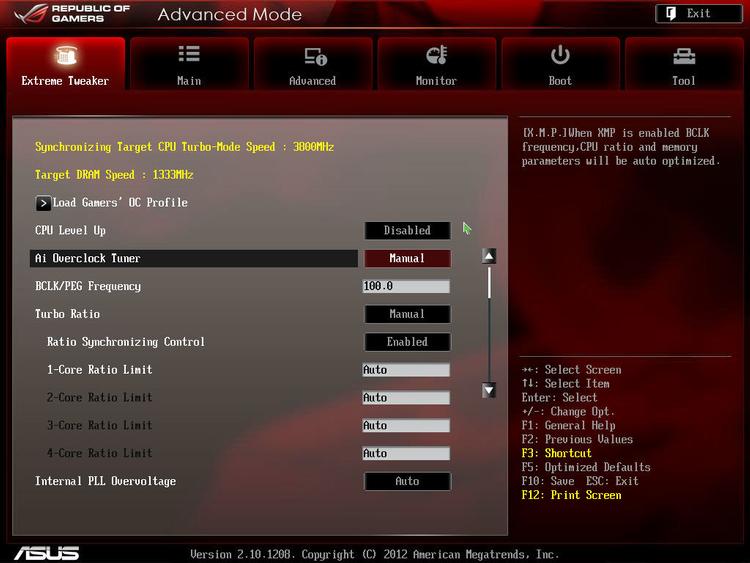
How to overclock the processor on a laptop?
Step 1: Check the stability of the processor
To ensure successful overclocking, we need to know that the CPU is stable both at idle and at maximum load. To do this, we will use a free program Prime95.
We will monitor the CPU temperature using the utility Core Temp, since it works with both AMD and Intel cores.
Step 2: Check your core temperature
When the above programs are installed. You will need to run the Core Temp program in order to monitor the CPU temperature right now.
Always look at the lowest temporary core temperature in order to make a rough calculation of how much to increase the values.
Step 3: Run stress tests
Now we want to compare the performance of your processor to see how it performs at 100%.
- Run Prime95, select "Just Stress Testing" and then you will be given a list of parameters you want to stress test on.
- Select "Blend Test" and press OK.
Step 4Enter BIOS
After about 5-10 minutes, once your temperatures have stabilized, you will need to start the Prime95 program.
- After that, you need to click on the button test, which is located at the top of the program, and then click on the button stop
- When the above steps are done, you will need to restart the PC, and as the screen appears, press the button "Delete" in order to enter the BIOS of your PC
IMPORTANT! Be sure to pay attention to the login method as the keystroke to enter your BIOS tends to be different for different device vendors.

Step 5: Go to Automatic Overclocking
Inside the BIOS, find the overclocking tab. In ours, this tab is called "OC Tweaker".
Setting the motherboard to run one of these profiles will allow it to attempt to overclock the chip to that frequency without any user action.
If you choose conservative overclocking, you can overclock your processor from 3.5 GHz to 4 GHz.
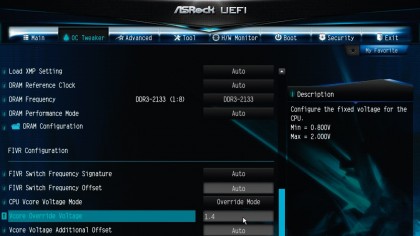
Step 6: Change the multiplier
More sophisticated users will opt for manual control, which is more convenient in terms of selection and operation. Otherwise, this is not particularly important, since we need to try to overclock our processor (CPU). First of all, we will try to distinguish it from 3.5 GHz to 4 GHz by changing the multiplier.

Step 7. Test Your Process at Maximum Load
- After you have changed the CPU multiplier to 40, save the changes and exit the BIOS.
- Now you need to restart your computer to open the Core Temp program. Always keep an eye on your CPU temperature! Don't close the program
- Then you need to open the Prime95 utility, then select the item Options, now click on Torture Test, and choose blend test. This is necessary in order to see how loaded your system is in this moment time.
If your system is stable for at least five minutes, we can continue increasing the multiplier to achieve higher overclocks and clock speeds.
Step 8Find Your CPU's Overclocking Limit
At this stage of overclocking your processor, you need to increase the multiplier by one and repeat the process of stress testing in Windows each time. This must be done until you get the blue screen of death.

Ideally, you want to prevent the appearance blue screen of death.
Step 9. Increase the voltage
To overcome the blue screen problem, we need to start working with Vcore voltage. Back in the BIOS, you need to find the Vcore Vcore Voltage Mode setting.
Change it to "Fixed". At this point, you may need to do some research into what's going on with your CPU's Vcore stock.
You need to start increasing the voltage by 0.01 volt each time until your PC starts to boot as before. After you reach the optimal voltage and stable Windows boot, you can close the BIOS.
Step 10. Run a Benchmark Test
To ensure stable overclocking, you should be benchmarking for as long as you see fit. Worth noticing that this procedure takes from three to 8 hours. But again, it depends on your patience and attitude towards your PC.
We hope this article has helped you overclock your CPU or at least made you interested in learning about overclocking. Let us know if you have ever overclocked your CPU!
Video: HOW TO OVERCLOCK A WEAK VIDEO CARD AND PROCESSOR?
Intel processor overclocking is a procedure for removing the restriction on the number of cycles processed for a period of time (1 sec.). Considering overclocking a processor without basic concepts in this area is not recommended.
general information
A clock cycle is a very small amount of time that is required to calculate the transmitted code, usually it is a small fraction of a second. The clock frequency is the number of cycles in 1 second. Overclocking provokes a minimum processing time.
The computer processes the information flow with the help of oscillations, the more the processor is able to process in one go, the higher the number of hertz (frequency unit). Accordingly, we force the processor to work in freelance mode, leaving less time for unloading.
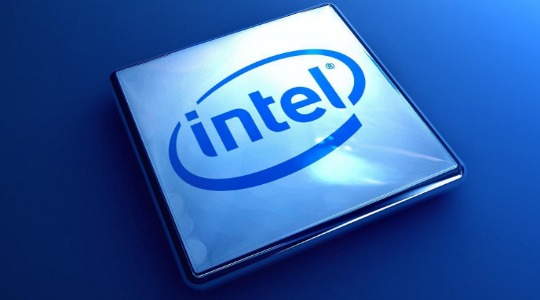
There are several types of frequencies:
- External - this is the frequency of data transfer between different equipment, even within the same system unit;
- Internal - this is the speed of the equipment itself (which we will increase).
Obviously, if you overclock, the computer will process more information in the same period of time, due to a longer clock cycle. Mostly, the procedure is used to extend the computer's relevance. It's no secret that technologies are gradually being modernized, and computers no longer meet modern requirements. Thanks to overclocking, you can somewhat postpone the purchase of a new PC.
What you need to know before overclocking an Intel processor?
CPU overclocking Intel Core must be carried out wisely, otherwise it is fraught with an early failure of the processor or the failure of its work instantly. It is important to reach the maximum speed, but not to exceed this limit. Each processor can be overclocked to a different maximum speed, often there is a mention of this in the documentation or on the Internet. Usually you can get 5-15% more speed, there are more significant gains, but it all depends on the model.
The best overclocking software AMD processor will allow your computer to work much faster and perform complex tasks more efficiently. AMD is a type of microprocessor for personal computers and laptops manufactured and manufactured by AMD.
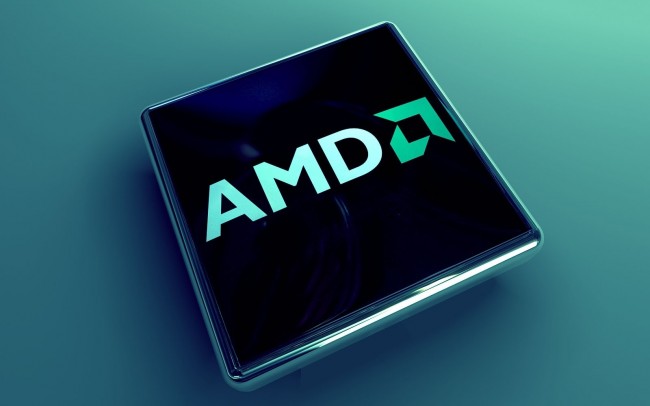
The technology of such microprocessors allows you to perform tasks with high performance for 32 bit systems. Newer categories of processors have acquired support for 64-bit computing.
The processor built into the system is not using all of its resources. Thus, its service life is extended. Acceleration must be carried out purposefully and irregularly. Otherwise, you can cause serious damage to the hardware components of your PC or laptop. Consider the most effective applications that can increase the frequency of the processor from AMD.
Utility Over Drive
Powerful application for AMD 64. The program is absolutely free. You can download it from the official website of the company.
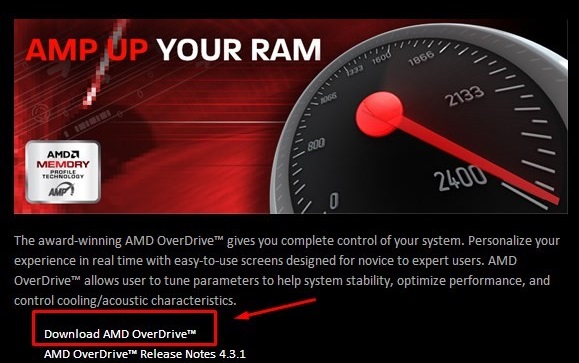
Immediately after the first launch of the program, a dialog box pops up that warns the user that he is fully responsible for all actions taken in the program that can lead to processor failure. After agreeing with the information provided, the main window of the program will appear.
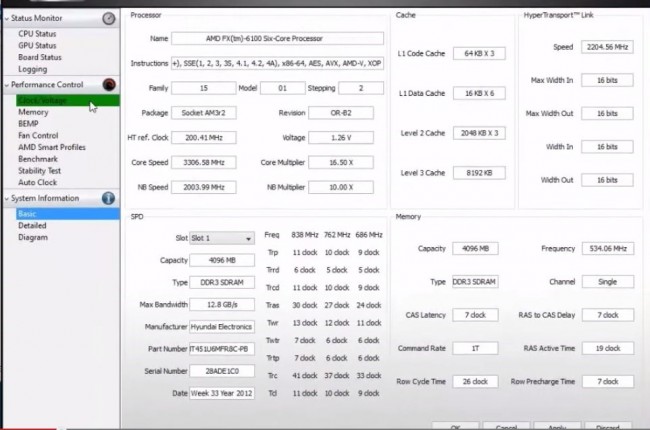
Follow the instructions to overclock the system microprocessor:
- On the left, find the item called Clock Voltage;

- Examine the window that appears carefully. The first column of data is the clock speed of each available microprocessor core. The second tab is the ordinal multiplier of the kernel, this number needs to be changed;
- To set the multiplier, you must click on the Speed Control button. She's highlighted in green in the picture below. Then adjust the sliders.
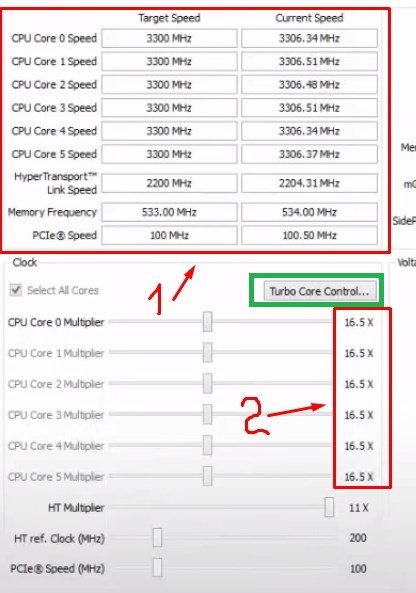
Overclocking with Advanced Clock Calibration
ACC is a feature for AMD athlon overclocking. The peculiarity of this application is that the adjustment and selection of the necessary frequencies are carried out very accurately. You can work with the application both in the operating system itself and in the BIOS.
To adjust the operation of the central microprocessor, go to the Performance Control tab in the motherboard menu. The key is located at the top of the utility's main toolbar.

The power system of a computer or laptop and the level of operation of the cooling system also affect the success of overclocking.
ClockGen program
The main purpose of the utility is to increase clock frequency microprocessor operation through the program in real time. Also, using the convenient program menu, you can overclock other hardware components: system buses, memory. The program is equipped with a powerful frequency generator and several system monitoring tools that can be used to regulate the temperature of components and control the operation of the cooling system. You can download the program from this link.

Brief instruction by use:
- To overclock the processor, run the utility. On the left panel of the main window, find the item PLL Control and click on it;
- Two sliders will appear on the right side of the window. Slowly change the position of the Selection slider. Remember! You need to do this little by little and very slowly. Sudden dragging can cause overclocking and instantaneous failure of the processor or other hardware components of the computer;
- Press the button to apply changes.
In the same way, you can speed up the work random access memory and system buses. To do this, select the required component in the PLL Setup window. The top panel of the program shows a kind of clock that displays the power of the hardware components. The program is available in Russian after installing the crack.
Remember! Any microprocessor frequency that goes beyond the normal value violates the hardware component agreement in the first place. If the processor fails, its warranty will be lost. Any device after the overclocking procedure loses the warranty.
Thematic videos:
During production, processor manufacturers always set the average frequency selected during testing. That is, you can slightly change the frequency and thereby increase processor performance by 15 percent.
There is a huge amount various programs to overclock your computer's processor.
To overclock we need:
- the computer itself;
- CPU Tweaker program;
- SetFSB program.
Overclocking Instructions
So, before starting the overclocking process, you need to install the SetFSB program. This program is considered the most secure and allows you to easily change the system bus frequency.
Next, run the program you installed by double-clicking on it with the left mouse button. Study the program well. As you can see the program is very simple and clear interface and even novice users should have no problem using it.
Go to the second tab, which is called "Control" and you will see the current system bus frequency of your processor and a little lower the slider that allows you to change its value.
On the third tab called "Customize" you can change Extra options systems.
Try to experiment with the settings of the program, only when you change the processor bus frequency be careful. The frequency needs to be increased a little bit, for example, increased by 50 MHz, immediately check the processor temperature and if everything is fine, then add 50 MHz and so on.
To configure your processor settings directly from operating system install CPU Tweaker. This program allows you to change the settings of your computer without increasing heat dissipation and power consumption.
The main thing when overclocking and tuning is not to overdo it, so that later you don’t have to buy new processor or computer.
